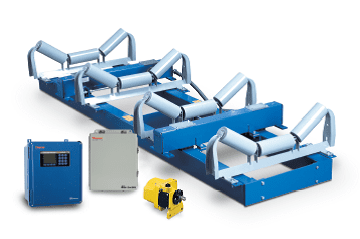Miners are often presented with the choice between pivoted belt-weighers and fully floating belt-weighers. For some, it’s hard to see the difference, while others may favour one particular model over another.
We sat down with SRO Technology’s General Manager of Engineering Peter Gensch, who provided his professional insight regarding the matter.
1. There are many different styles of belt weigher in the market. Two stand out variations are the “fully floating” belt weigher and the “pivoted” belt weigher. What are the main differences between these two arrangements?
Firstly, all manufacturers have designs that, generally, fall into one of the these two categories, and there are also many designs that don’t meet some of the important design criteria.
Most fully floating weighers have longer weigh lengths, and their weigh areas are suspended at multiple points by two or more load cells. Their design should ensure complete mechanical decoupling of unwanted forces in the load cells as well as utilise weigh carriage restraints that don’t impair the load signal.
These specifications are implemented to create more accurate accounting and trade measurement applications. As a result, fully floating weighers are typically good for an in-service accuracy of 0.25 – 0.5 per cent.
Pivoted weighers, on the other hand, generally cost less and use a simplistic design that’s more suitable for monitoring processes and controlling applications. The in-service accuracies for pivoted weighers typically range from 1.0 – 3.0 per cent, depending on the application, location and installation quality.
2. The industry seems to accept that fully floating belt weighers are the ‘premium’ option, but are there any benefits of a pivoted system?
Although pivoted weighers are not as precise as some fully floating counterparts, SRO Technology’s pivoted weighers are consistent and durable. In addition, they still serve a purpose in control applications, especially as affordable alternatives where high accuracy isn’t a huge priority.
Pivoted weighers’ robust construction and simple design make them far more reliable than any of the multi-cell weighers on the market. They’re a good long-term investment, especially considering the fact that they don’t incur many ongoing maintenance costs. Thanks to the reduced footprint of the scale system, we offer mines the opportunity to temper upkeep expenses and benefit from a low initial capital expenditure.
3. What are the limitations of the pivoted system?
One of the biggest limitations of pivoted weighers, which is typically overlooked, is their inability to simulate a closely representative static test load, particularly on conveyors that use offset idlers.
A significant belt incline will also create the same problem. Additional, small horizontal forces that occur around the pivot cannot be simulated or easily compensated for with any static load. Ultimately, these factors introduce a degree of nonlinearity that isn’t represented.
4. How do you recommend that customers decide on the best instrument for each application?
Ideally, they would have a clear understanding of their application and a realistic expectation of what the specifications are capable of before investing, but this is rarely the case.
That’s where we come in. By contacting SRO and discussing their applications with one of our experienced applications engineers, we can guide them in the right direction to ensure they get the best purpose-built weighing system for their operations and budget.
In doing this, we also help them consider the differences in specifications, instrument lifecycles, initial capital costs and the realistic ongoing maintenance expenses necessary to maintaining reasonable service accuracy.



Recent Comments